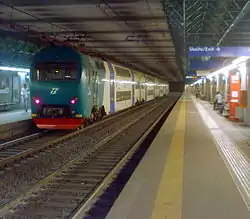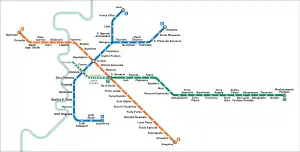| FL lines | |||
|---|---|---|---|
 | |||
| Overview | |||
| Area served | Rome metropolitan area, Lazio | ||
| Locale | Rome, Lazio | ||
| Transit type | Commuter rail | ||
| Number of lines | 8 | ||
| Number of stations | 128 | ||
| Daily ridership | 373,000 | ||
| Website | trenitalia.com | ||
| Operation | |||
| Began operation | 1994 | ||
| Operator(s) | Trenitalia | ||
| Infrastructure manager(s) | Rete Ferroviaria Italiana | ||
| Rolling stock | E.464, TAF, Jazz, ETR 421/521/621 Rock | ||
| Technical | |||
| System length | 672 km (417.6 mi) | ||
| Track gauge | 1,435 mm (4 ft 8+1⁄2 in) standard gauge | ||
| Electrification | 3 kV DC, overhead line | ||
| |||
The FL lines, formerly Lazio regional railways (Italian: ferrovie regionali del Lazio, also Ferrovie Laziali) consist of 8 commuter rail lines operated by Trenitalia, converging on the city of Rome.
Lines FL1, FL2 and FL3, particularly in areas closer to Rome, function like a rapid transit service, integrated with the Rome Metro and surface transportation. The other lines (numbered from FL4 to FL8) are served by traditional regional trains, and used almost exclusively for commuter traffic.
All eight lines are considered regional trains by Trenitalia. On timetables and departure boards at the stations the trains are marked with the letter R (Regional). The numbering of the lines (FL1, FL2, ...) appears only in some informational materials and on the signs of some stations. However, in the ATAC network, the numbering appears in all network maps.
Lines
| Line | Terminals | Year opened | Daily ridership | Length | Stations | Operator |
|---|---|---|---|---|---|---|
| Orte - Fiumicino Aeroporto | 1994 | 65,000 | 118 kilometres (73 mi) | 26 | Trenitalia | |
| Roma Tiburtina - Tivoli | 1994 | 22,000 | 40 kilometres (25 mi) | 13 | Trenitalia | |
| Roma Tiburtina - Viterbo Porta Fiorentina | 1999 | 60,000 | 88 kilometres (55 mi) | 28 | Trenitalia | |
| Roma Termini - Frascati / Albano Laziale / Velletri | 1994 | 55,000 | 24 kilometres (15 mi) / 29 kilometres (18 mi) / 41 kilometres (25 mi) | 20 | Trenitalia | |
| Roma Termini - Civitavecchia | 1994 | 40,000 | 77 kilometres (48 mi) | 14 | Trenitalia | |
| Roma Termini - Cassino | 1994 | 50,000 | 137 kilometres (85 mi) | 22 | Trenitalia | |
| Roma Termini - Minturno-Scauri | 1994 | 40,000 | 137.4 kilometres (85.4 mi) | 13 | Trenitalia | |
| Roma Termini - Nettuno | 2004 | 40,000 | 60 kilometres (37 mi) | 12 | Trenitalia |
Frequencies
Sections with one train every 15 minutes:
- Fiumicino Aeroporto - Fara Sabina (line FL1)
- Roma Ostiense - Cesano di Roma (line FL3)
Sections with one train every 30 minutes:
- Fiumicino Aeroporto - Fara Sabina - Poggio Mirteto (line FL1)
- Roma Tiburtina - Lunghezza (line FL2)
- Cesano - Bracciano (line FL3)
- Roma Termini - Civitavecchia (line FL5)
Sections with one train every 60 minutes:
Fares
For travel between stations in the City of Rome, ticketing is integrated with the Metrebus Rome system. A passenger may use the integrated ticket "BIT" from €1,50 (valid for 100 minutes) or any other type of integrated ticket or Metrebus pass; in addition, Trenitalia sells special "Anello" tickets where one may travel on any Trenitalia train within the City of Rome with a single €1 ticket (valid for 90 minutes). The "Anello" and the Metrebus Rome tickets are only valid within Rome, bounded by the stations: Capannelle (FL4 and FL6), Cesano di Roma (FL3), Fiera di Roma (FL1), Lunghezza (FL2), Roma Aurelia (FL5), Settebagni (FL1) and Torricola (FL7 and FL8).
For all trips that take place outside the "Anello" ring, or that cross through the ring, the typical regional mileage rate applies.
Rolling stock
Much of the service is operated by double-decker trainsets, usually operating in double formations. The fleet of convoys operating on the network is made up of:
- Treno ad alta frequentazione (TAF): introduced in 1998 and is the most used train on much of the network;
- Jazz: since 2014, used only on the FL4 line;
- E.464 + Vivalto: The E464 locomotive coupled to the Vivalto double-decker carriages, this type of train is mainly used on the FL5, FL6, FL7 and FL8 lines.
- Caravaggio: introduced in 2021, the new high-traffic train aimed at replacing the old TAFs, operating mainly on the FL1 and FL3 lines.[1]


.jpg.webp)

Planned extensions
Following the upgrading of the Rome railway hub by RFI, new FL stops will be built such as Roma Pigneto, in correspondence with the Pigneto station of the metro, which will be the third busiest railway hub in Rome after Roma Termini and Roma Tiburtina,[2] and track doubling and quadrupling will be implemented on the existing sections as well as technological upgrades for the safety and control of train movement (the implementation of the European Rail Traffic Management System (ERTMS) in the Rome hub is expected by 2024[3]).
In June 2022, 32 years after the 1990 FIFA World Cup, the Valle Aurelia - Vigna Clara route was reactivated with the related Vigna Clara stop, which will be a fundamental part of the so-called "Cintura-Nord" (Northern Belt), whose closure, expected for years, will to complete the Rome railway ring.
A year later, in June 2023, the Val d'Ala station was reopened, which is served by some trains of the FL2 line that leave and return from the "Roma Smistamento" depot.
Network map
See also
Bibliography
- Blasimme, Paolo (May–June 1968). "Il treno-metrò di Roma". Italmodel Ferrovie (139): 4520–4525.
- Cruciani, Marcello (September 1994). "Roma per i suoi pendolari". I Treni (152): 26–28.
- De Grisantis, G. (April 1977). "Il servizio urbano FS a Roma". Italmodel Ferrovie (203): 234–238.
References
- ↑ "In servizio il primo Rock a 6 casse della DPR Lazio" (in Italian).
- ↑ "NODO DI PIGNETO" (in Italian).
- ↑ "ERTMS HD nei Nodi Urbani (par. 8.1.6)" (in Italian).
External links
![]() Media related to Ferrovie Laziali at Wikimedia Commons
Media related to Ferrovie Laziali at Wikimedia Commons


